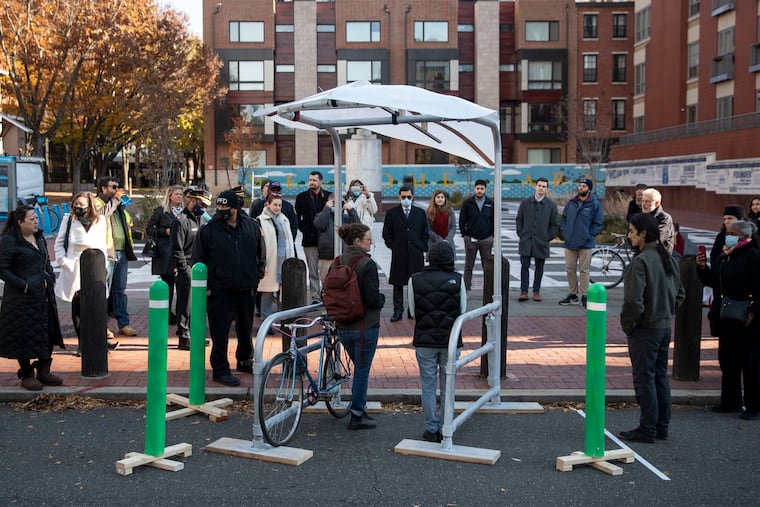Philly is trying a new bike rack to stop cars from blocking fire hydrants
It's not clear when or how widely the new bike racks will appear in the city.

Drivers hate circling Philadelphia blocks endlessly, and some will park anywhere — even if it’s an illegal spot in front of a fire hydrant. Firefighters sometimes must smash car windows to hook up hose.
Meanwhile, cyclists grumble constantly about full bike racks.
Now, a coalition of government agencies, planners and enterprising young transportation designers think they’ve found a solution to these three urban problems: A new kind of bike rack.
Developments: A team of three friends, all industrial designers who met in graduate school, has been named winner of a contest to design a new kind of bike corral for the street space around fire hydrants. It would create needed parking for bicycles and keep cars away, while providing easy (and ax-free) access for firefighters.
Team Sophon, as they call themselves, will get a $3,500 prize, and at least two of their corrals will be built and installed — one in West Philadelphia and one in Old City, near a garage owned by the Philadelphia Parking Authority.
“We want to put these on the street,” said Clarena Tolson, deputy executive director of PPA, the lead agency for the effort.
Why it matters: Philadelphia ranks in the top 10 of U.S. cities for bicycle commuting, and secure bike parking can be scarce. More than 14,000 city residents biked to work at least three days a week from 2014 through 2018, according to the Census Bureau’s American Community Survey, which measures trends between decennial counts. That’s 2.1% of commuting traffic.
Some neighborhoods use bikes at much higher rates. For instance, 19% of commutes in a census tract along Washington Avenue east of Broad Street were made by bicycle during the five years covered by the survey.
Last year, PPA wrote 31,380 tickets for illegal parking in front of fire hydrants. By law, 15 feet on either side of a hydrant must be kept clear of motor vehicles.
The winners: Sophon was composed of three recent graduates of the industrial design master’s program at Thomas Jefferson University. They wound up besting teams from established planning and engineering firms.
“When we got past the second round and beyond, in a way we didn’t know if we were supposed to be here,” Sophie Choi, 28, said, praising the quality of the competition.
Seventeen design teams entered the contest; five were short listed, and three finalists were picked.
Choi said the three labored over the prototype after work in teammate Corey Jameson’s backyard and at a coworking shop.
The corral, “Harbor,” is designed so cyclists can use space in front of the fire hydrant to stop and steer their bikes to the racks, made of thick steel tubing. Solar-powered lights in an overhead canopy would illuminate when users step inside, providing security.
» READ MORE: Philly’s new bike rack will keep cars from parking near fire hydrants
Judges from the city’s Office of Transportation, Infrastructure and Sustainability (OTIS), the Fire Department, Parking Authority and WTS Philadelphia, an association of professional women in transportation who work to diversify the industry, examined finalists’ entries on an early December day, questioning the designers. Some bicyclists drawn to the activity even rolled up and offered opinions.
Colin Lew, the third member of the Sophon crew, said the exercise taught the team the real-world lesson that designers have to adjust their vision to meet a client’s concerns and needs.
For instance, some of the selection committee thought the canopy could block sight lines in some places, obscuring street signage, he said. And the group’s plan to use bollards drew skepticism they’d be dangerous in a crash. Some suggested that the floppy high-impact plastic markers used on bike lanes would be better.
“The bike-rack space seems saturated, which means the design choices already out there were made for good reasons,” said Lew, 29. But still, “there’s a lot of ground to be trod between beauty and pragmatism.”
» READ MORE: Philadelphians want protected bike lanes and pedestrian safety on Spring Garden Street
Background: The idea of a dual purpose bike corral was inspired by a Tolson trip to study streetscapes in the bicycle nirvana of Copenhagen. In 2018, BillyPenn reported that the mayor’s Innovation Fund gave a $7,500 grant to OTIS to design a prototype.
That eventually morphed into the larger group of partners that together raised more money to put on the rack-design contest three years later, including installation, Tolson said. In addition to OTIS and the PPA, they included the Fire Department, the Delaware Valley Regional Planning Commission, and WTS Philadelphia.
LOOKING AHEAD: Next, officials from PPA will meet with the designers to refine the bike corral and to begin to make copies so they can be installed. Tolson said there is no set deadline and hopes to make it happen soon. Building out the corrals over time will depend on raising more money.